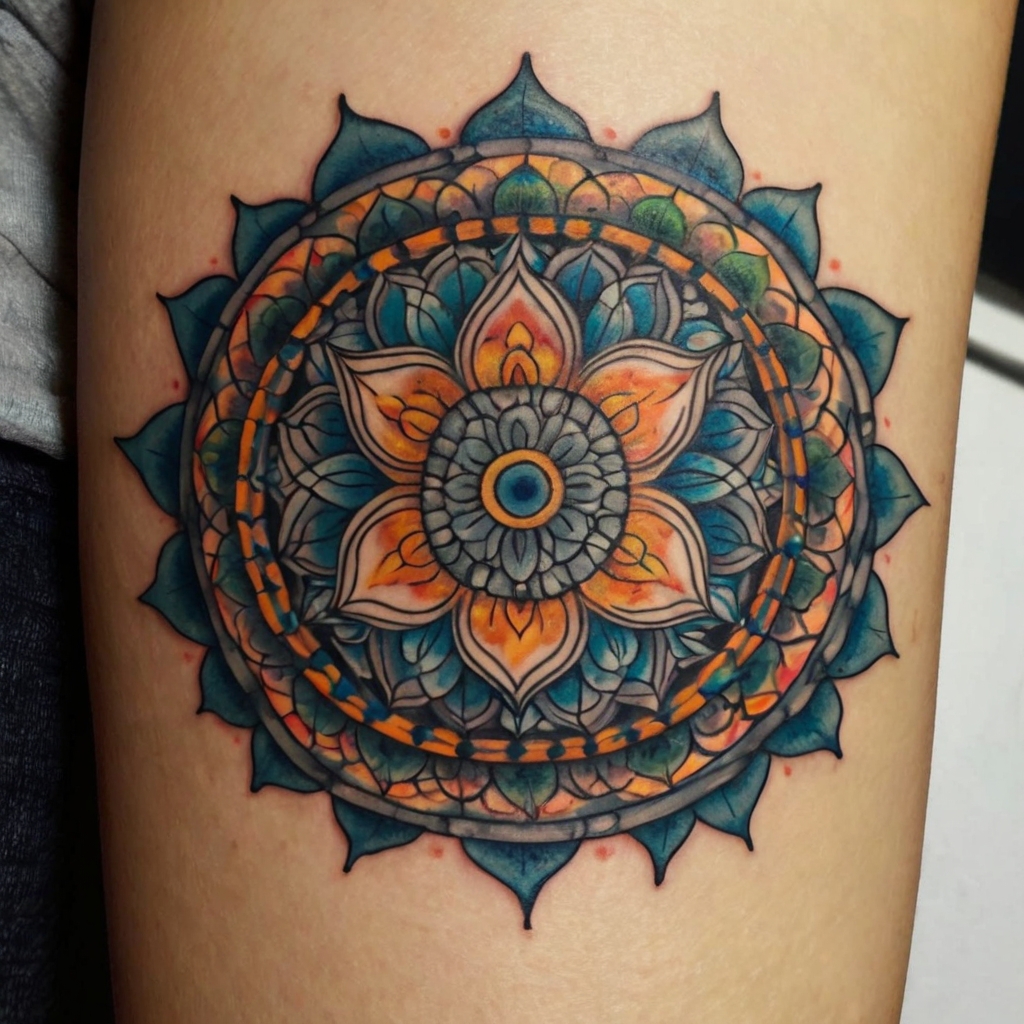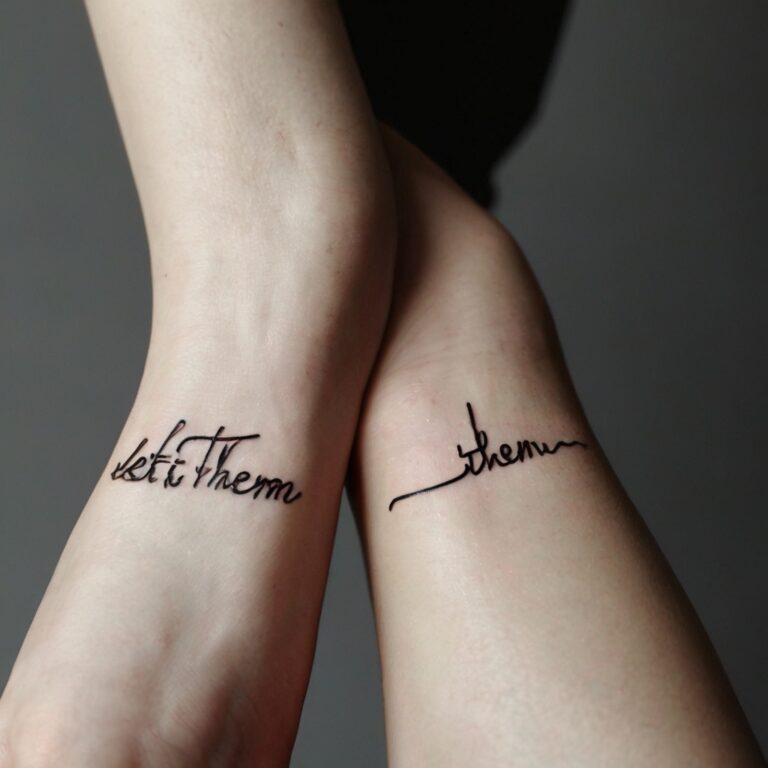Key Takeaways
- Symbolism: Mandala tattoos represent wholeness, balance, and eternity, symbolizing the universe and the interconnectedness of all life.
- Spiritual Roots: These designs originate from Hinduism and Buddhism, historically used for meditation and depicting the cosmos.
- Cultural Significance: Different cultures interpret mandalas uniquely, often incorporating them in rituals to emphasize spiritual growth and impermanence.
- Personal Connection: Mandala tattoos can serve as meditative tools and symbolize personal growth, inner peace, and self-awareness.
- Design Variations: Popular designs include geometric and floral mandalas, each carrying distinct symbolism related to order, unity, growth, and transformation.
- Considerations for Choosing: Factors like design elements, color choices, cultural significance, artist expertise, and placement should be considered when selecting a mandala tattoo.
Exploring the Mandala Tattoo Meaning
Mandala tattoos symbolize harmony, unity, and the universe’s cyclical nature. These designs often represent the journey towards completeness and self-awareness.
Origins and Historical Significance
Mandala tattoos have roots in ancient spiritual traditions. Originating from Hinduism and Buddhism, mandalas served as spiritual symbols representing the cosmos. Monks and practitioners used mandalas during meditation, believing the intricate patterns fostered connection to the divine. With precise geometric layouts, they have been utilized in rituals and sacred art forms for centuries.
Cultural and Spiritual Interpretations
In various cultures, mandala tattoos carry different spiritual interpretations. Hindus integrate mandala designs in their temples and rituals, emphasizing symmetry as the universe’s blueprint. Buddhists create sand mandalas to represent the transient nature of life, destroying them after completion as a ritualistic reminder. In contemporary spirituality, mandala tattoos embody personal growth, inner peace, and connection to a higher consciousness. Individuals often select specific shapes and colors to align with their personal spiritual path, using the tattoo as a meditative and reflective tool.
The Symbolism Behind Mandala Tattoos
Mandala tattoos symbolize wholeness, balance, and eternity, drawn from ancient spiritual traditions like Hinduism and Buddhism. Central to these traditions, the mandala represents the universe, interconnectedness of life, and personal journeys towards completeness, harmony, and self-awareness.
Representation in Different Cultures
In Hindu temples, mandalas depict the cosmos, highlighting the divine structure of the universe. Hindu rituals often use mandalas to create sacred spaces, emphasizing spiritual growth. Buddhist monks and practitioners use mandalas in meditation, reflecting the transient nature of life through intricate sand mandalas. When completed, these sand mandalas are purposefully destroyed to symbolize impermanence.
Personal and Psychological Dimensions
Mandala tattoos can embody personal growth and inner peace. You might choose specific designs representing your journey towards self-awareness and harmony. Psychologically, mandala tattoos serve as meditative tools. They help focus the mind, leading to deeper introspection and connection to a higher consciousness. Personal stories often drive the selection of a mandala, infusing each tattoo with unique, meaningful symbolism that aligns with individual aspirations and experiences.
Popular Mandala Tattoo Designs
Mandala tattoos symbolize wholeness, balance, and eternity. They represent the interconnectedness of life, personal journeys towards harmony, and self-awareness.
Geometric Mandala Tattoos
Geometric mandala tattoos feature precise shapes and symmetrical lines. These designs often incorporate circles, squares, and triangles, creating intricate patterns that establish a sense of order and unity. They can symbolize the universe’s structure, reflecting how different aspects of life connect and balance each other. Many people choose geometric mandalas to represent clarity and focus in their personal journey.
Floral Mandala Tattoos
Floral mandala tattoos combine traditional mandala patterns with floral elements. These designs often feature petals, leaves, and vines radiating from the center, merging nature’s beauty with spiritual symbolism. They signify growth, transformation, and the natural cycles of life. By adding flowers, individuals may highlight aspects like love, beauty, or resilience, each flower carrying its own unique message. Such tattoos can resonate deeply with those seeking harmony between their inner world and the natural environment.
Choosing the Right Mandala Tattoo
Mandala tattoos represent wholeness, balance, and eternity. They symbolize the interconnectedness of life and personal growth. These designs resonate with harmony and self-awareness, allowing individuals to select patterns that align with their aspirations.
Factors to Consider
Design Elements: Focus on design elements that reflect personal beliefs or experiences. Incorporate specific symbols like lotus flowers or geometric shapes to add personal meaning.
Color Choices: Use specific colors to enhance the tattoo’s symbolism. Blue can denote tranquility while red may represent passion and strength. Choose a palette that aligns with your intentions.
Cultural Significance: Consider cultural implications when choosing your mandala tattoo. Different cultures attribute various meanings to patterns and symbols, so ensure your design respects these traditions.
Artist Expertise: Select a tattoo artist experienced in mandala designs. Look at portfolios to evaluate their skill in creating intricate, symmetrical patterns.
Placement Ideas and Their Significance
Arm Tattoos: Mandalas on the arm can symbolize strength and personal growth. This visible placement can serve as a constant reminder of your journey.
Back Tattoos: Choose the back for a larger canvas to incorporate detailed designs. This placement can reflect a journey of transformation and the unfolding of life paths.
Chest Tattoos: Opt for the chest to keep the design close to your heart. This placement can signify inner peace and emotional balance.
Leg Tattoos: Consider the leg for designs that represent movement and progress. The lower body placement can symbolize the journey and forward motion in life.
Hand and Wrist Tattoos: Use these areas for smaller, simpler designs. Hand and wrist tattoos can represent mindfulness and personal empowerment.
Conclusion
Choosing a mandala tattoo is more than just an aesthetic decision; it’s a journey toward self-discovery and spiritual growth. Each design element and color choice holds deep meanings, allowing you to express your inner world uniquely. Whether you’re drawn to geometric patterns or floral variations, your mandala tattoo can symbolize your personal growth and interconnectedness with the universe.
Remember to consider the cultural significance and consult an experienced artist to bring your vision to life. The placement of your tattoo also adds layers of meaning, reflecting aspects like strength, transformation, and emotional balance. Ultimately, a mandala tattoo serves as a lifelong reminder of your journey toward wholeness and inner peace.
Frequently Asked Questions
What is the symbolic meaning of mandala tattoos?
Mandala tattoos symbolize wholeness, balance, and eternity. They are rooted in Hinduism and Buddhism, representing interconnectedness, personal growth, and inner peace.
How do mandalas aid in meditation and self-awareness?
Mandalas serve as visual tools that help focus the mind during meditation, fostering self-awareness and inner peace. Their intricate designs encourage mindfulness and contemplation.
What are the popular designs for mandala tattoos?
Popular mandala tattoo designs include geometric patterns, which symbolize clarity and focus, and floral variations, representing growth and natural cycles.
What should I consider when choosing a mandala tattoo?
Consider design elements, color choices, cultural significance, and the expertise of your tattoo artist. These factors ensure that the mandala tattoo aligns with your personal and aesthetic preferences.
Where are common body placements for mandala tattoos?
Common placements include the back, forearm, chest, and thigh. Each location carries symbolic significance, such as strength (forearm), transformation (chest), and emotional balance (thigh).
Do the colors in mandala tattoos have specific meanings?
Yes, colors in mandala tattoos have specific meanings. For example, blue symbolizes tranquility and wisdom, while red represents passion and energy. Choosing colors thoughtfully can enhance the symbolic intent of your tattoo.
Are mandala tattoos culturally significant?
Yes, mandala tattoos carry deep cultural significance, particularly in Hinduism and Buddhism. They symbolize spiritual journeys, with their intricate designs reflecting the universe and life’s complexities.
Can a mandala tattoo be personalized?
Absolutely. You can personalize a mandala tattoo by incorporating elements meaningful to you, such as initials, dates, or symbols. This makes the tattoo unique and personally significant.
How do I choose the right tattoo artist for a mandala tattoo?
Select an artist with expertise in detailed, intricate designs. Review their portfolio to ensure their style matches your vision. Experienced artists can bring out the intricate beauty of mandala tattoos.
What is the healing process for a mandala tattoo?
The healing process typically takes 2-4 weeks. Keep the area clean, moisturized, and avoid sun exposure to ensure proper healing. Follow your tattoo artist’s care instructions carefully.







